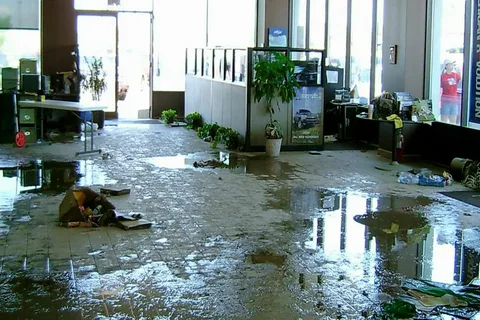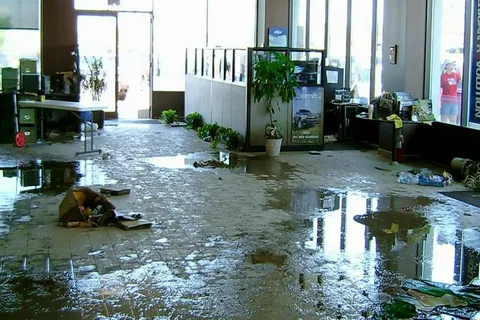The Blue Mountains, known for its breathtaking views and serene landscapes, is also prone to natural disasters such as floods. These devastating events not only cause damage to homes and properties but also leave a lasting impact on the affected individuals and communities. As a result, it is crucial to have reliable and efficient flood restoration services in the Blue Mountains to help restore not just homes but also hearts. In this blog post, we will discuss the importance of flood restoration Blue Mountains and provide helpful information on the process and services available.
Understanding the Scope of Flood Damage Blue Mountains
Floods are a common occurrence in the Blue Mountains, and their devastating effects cannot be underestimated. When a flood hits, it can wreak havoc on homes, properties, and infrastructure, causing significant damage and destruction. The scope of flood damage Blue Mountains is vast, ranging from structural damage to personal belongings.
Structural damage is one of the most visible and immediate consequences of flooding. The force and weight of the water can weaken foundations, compromise structural integrity, and even cause buildings to collapse. Floodwater can also seep into walls, ceilings, and floors, leading to mold growth and rotting wood. This not only affects the structural stability of a building but also poses serious health risks to its occupants.
Apart from structural damage, floods also result in the loss of personal belongings and sentimental items. Furniture, electronics, clothing, and cherished possessions can all be destroyed or irreparably damaged by floodwaters. The emotional toll of losing these items can be significant, as they often hold sentimental value and cannot be replaced.
Furthermore, floods can disrupt basic services such as water, electricity, and transportation. Sewage systems may become overwhelmed, leading to contamination and the spread of disease. Roads and bridges may be washed away or rendered impassable, isolating communities and hindering rescue and recovery efforts.
The Importance of Swift and Thorough Flood Restoration Blue Mountains
When a flood strikes in the Blue Mountains, time is of the essence. Swift and thorough flood restoration is not just important, but crucial for the well-being of affected individuals and communities. Here’s why:
 First and foremost, swift restoration helps mitigate further damage. The longer floodwater sits, the more it seeps into walls, floors, and furniture, causing structural damage and promoting the growth of harmful mold. Acting quickly can prevent additional harm and minimize repair costs.
First and foremost, swift restoration helps mitigate further damage. The longer floodwater sits, the more it seeps into walls, floors, and furniture, causing structural damage and promoting the growth of harmful mold. Acting quickly can prevent additional harm and minimize repair costs.
Thorough restoration ensures that every aspect of the property is addressed. This includes not only drying and cleaning but also repairs to damaged structures and the removal of hazardous materials. Thorough restoration guarantees a safe and healthy environment for residents to return to.
In addition to physical repair, flood restoration plays a significant role in restoring a sense of normalcy and well-being. It helps individuals and communities rebuild their lives by salvaging personal belongings, addressing emotional trauma, and providing support in navigating insurance claims and paperwork.
Moreover, swift and thorough flood restoration also aids in preventing long-term consequences. By addressing issues promptly, professionals can identify potential hazards and prevent future damage, such as weakened foundations or compromised electrical systems.
In times of distress, having reliable and efficient flood restoration services is paramount. Their expertise, equipment, and resources can make all the difference in ensuring a speedy recovery. Swift and thorough flood restoration not only restores homes but also restores hope and stability to the affected individuals and communities in the Blue Mountains.
Choosing the Right Professionals for Flood Restoration
Choosing the right professionals for flood restoration is crucial to ensure that the process is carried out effectively and efficiently. With numerous restoration companies available, it can be overwhelming to make the right choice. Here are some factors to consider when selecting professionals for flood restoration in the Blue Mountains.
First and foremost, experience is key. Look for a restoration company that has years of experience specifically in flood restoration. Dealing with floods requires specialized knowledge and expertise, and an experienced team will be better equipped to handle the unique challenges that arise during the restoration process.
Next, consider the range of services offered by the restoration company. Flood restoration is a complex process that involves various stages, such as water extraction, drying, cleaning, repairs, and mold remediation. Ensure that the professionals you choose can provide comprehensive services and have the necessary equipment and resources to handle each step of the restoration process.
It is also essential to verify the credentials and certifications of the restoration company. Look for certifications such as Institute of Inspection, Cleaning and Restoration Certification (IICRC), which ensures that the professionals adhere to industry standards and best practices.
Additionally, check for references and reviews from previous clients. Reading testimonials and speaking to others who have used the services of the restoration company can give you insight into their level of professionalism, reliability, and customer satisfaction.
Finally, consider the response time of the restoration company. In the event of a flood, every minute counts. Look for a company that offers 24/7 emergency services and can respond quickly to mitigate further damage.
The Comprehensive Steps in Flood Restoration Process
When it comes to flood restoration in the Blue Mountains, there are several comprehensive steps that professionals follow to ensure an efficient and effective process. These steps are crucial in restoring homes and properties to their pre-flood condition.
The first step is to assess the damage. Professionals will thoroughly inspect the affected area to determine the extent of the damage and identify any potential hazards. This assessment is essential in creating a customized restoration plan that addresses all the specific needs of the property.
Next, water extraction is carried out to remove any standing water from the property. Powerful pumps and extraction equipment are used to quickly and efficiently remove the water and prevent further damage.
Once the water is extracted, the drying process begins. Industrial-grade dehumidifiers and air movers are strategically placed to remove moisture from the air and accelerate the drying process. This step is crucial in preventing mold growth and further damage to the structure.
After the property is thoroughly dried, the cleaning and sanitization process begins. This involves cleaning all surfaces, including walls, floors, and furniture, to remove any contaminants or residue left behind by the floodwaters. Specialized cleaning agents are used to disinfect and sanitize the property, ensuring a safe and healthy environment.
The next step is repairs and restoration. Any damaged structures or materials, such as walls, floors, or electrical systems, are repaired or replaced. This step is essential in restoring the property to its pre-flood condition and ensuring its safety and functionality.
Lastly, mold remediation is conducted to address any potential mold growth. If mold is detected, professionals will use specialized techniques and equipment to safely remove the mold and prevent it from spreading. This step is vital for the health and well-being of the occupants and prevents any long-term consequences.
The Emotional and Psychological Impact of Flood Restoration
Flood restoration goes beyond just physical repairs and structural restoration; it also has a significant emotional and psychological impact on individuals and communities. The aftermath of a flood can leave people feeling overwhelmed, vulnerable, and traumatized. Losing personal belongings, cherished possessions, and the sense of security that comes with a safe home can be deeply distressing.
The emotional impact of flood restoration can manifest in various ways. Many people experience feelings of grief and loss as they come to terms with the damage and destruction caused by the flood. They may mourn the loss of sentimental items, family heirlooms, and photographs that cannot be replaced. Additionally, the disruption and displacement caused by a flood can leave individuals feeling uprooted, anxious, and uncertain about the future.
Psychologically, the experience of a flood can have long-lasting effects. Individuals may struggle with post-traumatic stress disorder (PTSD), experiencing flashbacks, nightmares, and heightened anxiety triggered by reminders of the flood. The constant fear of future floods can also contribute to a persistent state of hypervigilance and worry.
It is crucial to recognize and address the emotional and psychological impact of flood restoration. Professional restoration companies not only provide physical repairs but also offer support and guidance to individuals and communities during this difficult time. They can connect people with resources for emotional support, provide assistance in navigating insurance claims, and help individuals rebuild their lives and homes.
FAQs about flood restoration Blue Mountains
Got questions about flood restoration Blue Mountains? We’ve got you covered! Here are some frequently asked questions to help you navigate the process:
Q: What is flood restoration?
A: Flood restoration refers to the process of repairing and restoring homes and properties that have been damaged by floods. It involves steps such as water extraction, drying, cleaning, repairs, and mold remediation.
Q: How long does flood restoration take?
A: The duration of flood restoration depends on the extent of the damage and the size of the property. In general, it can take anywhere from a few days to several weeks to complete the restoration process.
Q: Can I do flood restoration myself?
A: While there are some DIY techniques for small-scale water damage, it is recommended to hire professionals for flood restoration. They have the expertise, equipment, and resources to ensure a thorough and efficient restoration process.
Conclusion
As we conclude our discussion on flood restoration in the Blue Mountains, it becomes evident that the impact of floods extends far beyond physical damage. The devastating effects of floods can leave individuals and communities feeling vulnerable, displaced, and overwhelmed. However, the importance of swift and thorough flood restoration cannot be overstated. Not only does it mitigate further damage, but it also provides a sense of hope and stability to those affected.
| Other Good Articles to Read |
| Skank Blogs |
| Unreal Blogs |
| Tba Blogs |
| All City Forums |
| Dany Blogs |
| Refuge Blogs |
| The Music Blogs |
| Key Forums |
| The Big Blog Theory |
| Joe Blogs |
| Blogs 4 Me |
| Blogs Emon |



